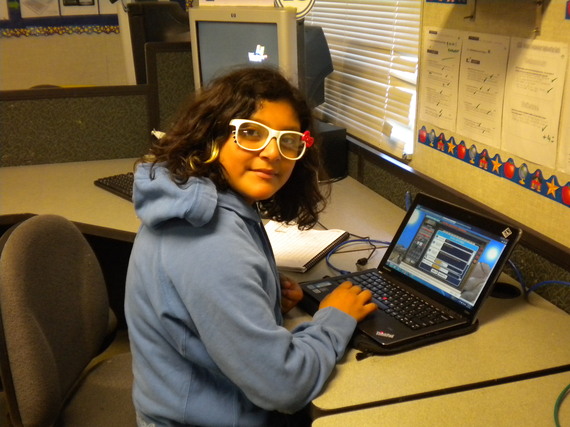Here at Techbridge we are looking forward to Hour of Code the second time around. Some of our girls will get their first taste of coding in our after-school programs. Others will delve into more advanced projects and experiment with cutting-edge technologies, hacking clothes and electronics and experimenting with breadboarding and circuit design.
Last year our staff got involved too. We worked our way through the Hour of Code's tutorial at a team party. Personally, I struggled through the first few steps in the tutorial. I eventually felt a sense of accomplishment that our girls experience when they work through a tech challenge. As I worked at my own pace, I noticed who picked up coding quickly and found myself comparing my progress to theirs. For me it was a reminder of what kids experience as they learn new technologies. It's not just about the tech skills but also the confidence that you can learn the skills and that getting to the finish line first, isn't necessarily the ultimate goal.
Hour of Code is a worldwide movement imagined by Code.org for the week of December 8-14, in celebration of Computer Science Education Week. Hour of Code offers an introduction to computer science that helps demystify code and shows that anybody can learn the basics. Last year over 15 million students in more than 180 countries participated.
What happens after Hour of Code? We know how important it is for kids to have opportunities that sustain their interest long-term. In Techbridge learning tech skills is good, but learning to persevere through challenges and meeting role models that connect activities to careers is even more important. In our programs, girls commit to a year. Some come back for a second year or more. We have had girls return year after year, some spending seven years with us. A safe and supportive program with caring adults and peers is important for working through technical projects and taking on the identity of someone who knows they can master computer science.
I encourage you to support efforts that build upon the Hour of Code movement. I offer up my top 10 list of suggestions to every influencer who can help turn a spark that starts with Hour of Code into a lifetime passion -- parents, teachers, after-school staff, tech workers, role models and interested adults.
1. You don't have to know how to code; you don't need to be a college graduate to influence a child. What really matters is encouragement, especially from parents. With Khan Academy, kids and parents can learn computer science for free together. Support programs that support families.
2. Find a program that you can support with your time. Volunteer to work alongside a classroom teacher or after-school staff. Volunteer as a mentor teacher with Technology Education and Literacy in Schools (TEALS) or check into US2020 for volunteer opportunities.
3. Donate to a program that is doing good work to engage kids in technology. There are groups like Techbridge, Girlstart, Level Playing Field Institute, and Black Girls Code who support youth who have much promise but need access to opportunities to discover they do like to code when it's relevant to their interests.
4. Pay it forward and be a role model. Learning how to code may not turn a kid on to computer science, but getting to know a role model who shares her passion for work can. FabFems and Million Women Mentors can connect you with organizations in your community in need of role models. Technovation mentors work with girls worldwide on app challenges.
5. Support a girl or boy who doesn't have the advantages that your family has. When you learn about tech opportunities that are coming up, share them with teachers so that they can get the word out to all families. Are there kids in your child's class who need help registering for a summer robotics program or getting to a weekend coding class? Reach out and offer to help.
6. Far too many kids don't have a home computer or access to the Internet at home. Don't let lack of access be their problem. Make it your concern and help find a solution. Comcast's Internet Essentials program helps bring affordable Internet and computers to families that qualify.
7. Code for good. Be the influencer who shows kids that they can make the world a better place with technology. As a role model, make explicit how technology helps you help others. As a parent or teacher, highlight examples in the news of tech being used for positive social impact.
8. Advocate to make computer science available to all students, beginning early on. It shouldn't matter what family a child is born into or what school she attends. Let's play fair with the introduction to computer science in every elementary school to help level the playing field.
9. Increase the availability of advanced computer science for all students, especially those who are members of underrepresented groups. Learn from the National Center for Women & Information Technology (NCWIT). Be the advocate to bring computer science courses to all high schools. Exploring Computer Science is a great model of a K-12/university partnership to democratize computer science.
10. Invest in educators in and out of school. Professional development matters. Make a donation to your neighborhood school or after-school program for training and ensure that educators are well supported so that they can introduce technology beyond the basics.
I am a fan of Hour of Code and Computer Science Week. I encourage you to find your way to keep the momentum going long after the hour and week of coding.
About Linda Kekelis
I know firsthand the powerful impact of sustained support on girls' perceptions of computer science and their options for the future. I am the CEO/Executive Director at Techbridge. Over the past 15 years, I have seen girls get inspired by a role model in elementary school and get turned on to computer science in middle school. These moments became sustained interests through the long-term and in-depth program approach of Techbridge.
About Techbridge
Techbridge empowers girls by inspiring them in science, technology, and engineering. Techbridge serves girls in after-school and summer programs in the San Francisco Bay Area and Greater Seattle and is launching in Washington, DC in 2015. Through partnerships, Techbridge provides training and builds the capacity of youth-serving groups to increase access and opportunities in STEM for youth. For more information about Techbridge, visit www.techbridgegirls.org.
Follow Linda Kekelis on Twitter: twitter.com/LindaKekelis
Techbridge Girls on Twitter: www.twitter.com/techbridgegirls

